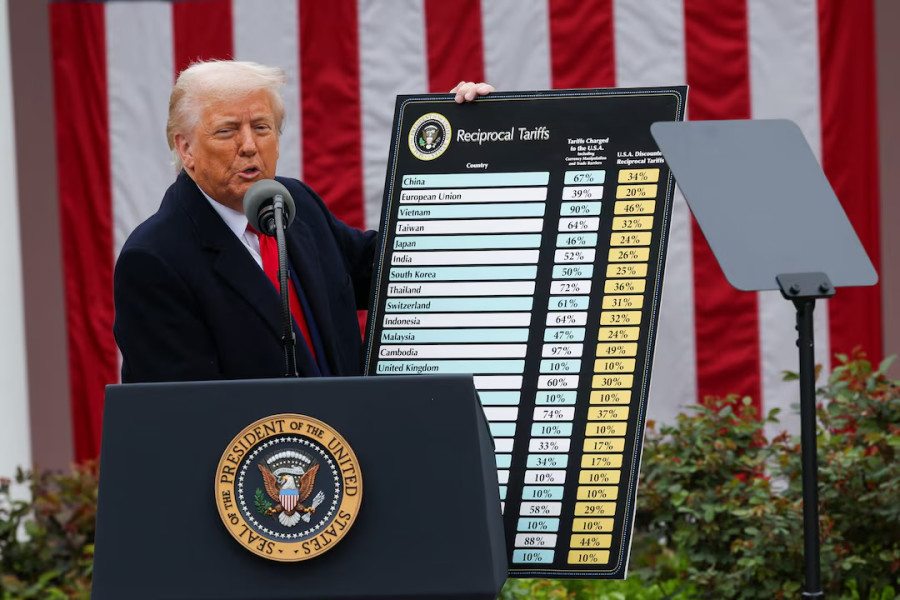Columns
Trump’s tariffs divide the South
The US market is vital for developing countries, requiring them to accept Trump’s negotiation terms.
Prakash Bhandari
On April 2, the United States imposed the most sweeping tariff hikes in recent history, disproportionately affecting its trade partners. While the developing world has reacted with fragmented strategies, China seems determined to respond with reciprocity and consolidate a collaborative front among developing countries against the US’s move. However, countries like India and Vietnam declined such collaboration and opted to negotiate individually.
Such fragmentation not only reflects a lack of unified strategy, but it also signals a complex interplay of divergent economic needs, national interests and unfolding geopolitical realities. This article examines key patterns contributing to these fragmented strategies and reflects on their future position in the global trading system, especially in the context of ongoing US-China trade tensions.
Trump's imposition of diverse degrees of tariffs has disproportionally affected developing countries. The US hit China with a staggering 145 percent, while other developing countries like India, Vietnam, Bangladesh, Sri Lanka and Pakistan are also heavily affected. The looming uncertainty about US policy has raised scepticism among developing countries, even as Trump has promised a 90-day suspension of tariffs for most countries.
The visit of Chinese President Xi Jinping to three South East Asian countries, Vietnam, Malaysia and Cambodia, from April 14 is considered to be a part of China’s efforts to retaliate with reciprocal tariffs and embolden regional alliances. Likewise, China has also reached out to India, proposing joint efforts against the US’s tariffs. For instance, highlighting the mutual benefits of a Sino-Indian collective stance, spokespersons from the Chinese embassy in Delhi recently stated, “Facing the US abuse of tariffs…the two largest developing countries should stand together to overcome the difficulties.”
However, forming a collective front seems less likely as most countries opted for bilateral moves. Immediately after Trump’s announcement on April 2, countries like India, Vietnam, Malaysia and Indonesia rushed for individual deals with the White House. They urged that they were ready to accommodate the US's concerns.
Bilateralism over collective push
Certain factors make bilateral relations more attractive for developing countries. First, border trends such as fragmentation in world politics, the rise of economic nationalism and protectionism and trade wars resulted in a decline in globalisation. The multilateral trading mechanisms like the World Trade Organisation (WTO) are losing momentum. Hence, developing countries see leverage in one-to-one negotiations in this divided world. India, for instance, has prioritised bilateral trade negotiations over multilateral ones for a long time. For example, India declined to participate in the Regional Comprehensive Economic Partnership (RCEP) in 2019 and chose to consolidate bilateral trade agreements.
Second, developing countries consider the Trump tariff as an opportunistic move to secure the American Market. With the ambition of prosperity, developing countries view access to the US market as essential to fulfilling their developmental ambition. For instance, former Indian diplomats to the US advocated for a bilateral deal with the US to “gain market access beyond competitor”, citing how US market access fuelled rapid growth in countries like China, South Korea, and Japan in the past. As a competitor, they regard the US’s divergent tariff approach as an opportunity to capitalise on the market.
According to India's industry minister, Piyush Goyal, the US is trying to reset the game's rules, which is a good amendment for India in some sense, as it opens up opportunities. He believes that the post-tariff scenario is the race to reach a deal with the US. Hence, many developing countries have pursued a transactional approach and quest to benefit from this tariff moment.
Likewise, developing countries tend to leverage the great power competition. For instance, during the Cold War, China aligned with the US, distancing itself from the Union of Soviet Socialist Republics for its strategic advantage. Today, India and other countries seek to leverage the US-China rivalry to strengthen their agency and strategic autonomy.
Third, China is viewed by the developing world with scepticism as they are wary about their heavy reliance on China. Although China provides vital resources like infrastructure investments, technologies and supply chain integration, its weak domestic demand and slowing economy make it a less attractive market. Hence, concerns are growing that the US’s heavy tariffs may divert Chinese goods into developing countries’ markets, potentially undermining local manufacturing and jobs.
Developing countries are economically diverse, particularly regarding export dependency and economic priorities. As the World Bank data shows, Vietnam, Thailand and the Philippines rely on exports, 87 percent, 65 percent and 27 percent of their GDP, respectively, whereas India's export contributes just 22 percent of its GDP. These differences shape their diversified interests and leverage for trade negotiation and influence their mediation choices.
Further, as the US remains a major export destination in many developing nations like India, Vietnam and Indonesia, and only limited alternative markets exist in the short term, these countries have little leverage to reciprocate Trump’s tariffs. Their primary concern is maintaining access to the market, as their development aspiration is highly reliant on exports to the US.
The US market remains indispensable for many developing countries in the short term, compelling them to accommodate Trump’s negotiation terms. However, as America is inclined more towards protectionism and its foreign policy becomes unpredictable, there is the possibility of evolving alternative multilateral centres of economic gravity along with China, the EU, Japan and others. Such a multilateral trading system might be alluring for developing nations as a relatively stable and multilateral architecture in this evolving age of uncertainty and chaos.




 22.64°C Kathmandu
22.64°C Kathmandu














